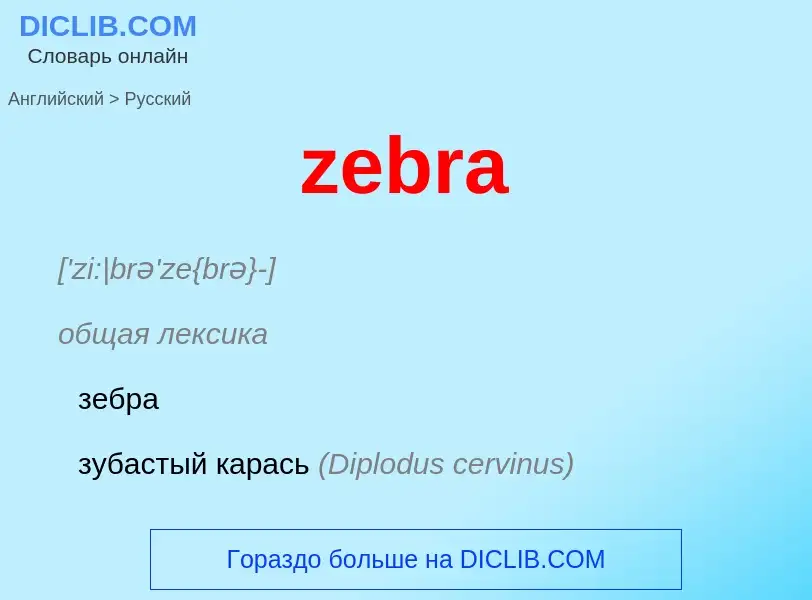Tradução e análise de palavras por inteligência artificial ChatGPT
Nesta página você pode obter uma análise detalhada de uma palavra ou frase, produzida usando a melhor tecnologia de inteligência artificial até o momento:
- como a palavra é usada
- frequência de uso
- é usado com mais frequência na fala oral ou escrita
- opções de tradução de palavras
- exemplos de uso (várias frases com tradução)
- etimologia
zebra - tradução para Inglês
['zi:|brə'ze{brə}-]
общая лексика
зебра
зубастый карась (Diplodus cervinus)
существительное
общая лексика
растение
животное или минерал с полосатой окраской
зоология
зебра (Equus zebra)
зебра
жаргонизм
«зебра» (о военнослужащем с нашивками)
младший командир
сержант
сленг
рефери
судья (американский футбол)
синоним
общая лексика
зебра Грэви (Equus grevyi)
Wikipédia

Zebras (US: , UK: ) (subgenus Hippotigris) are African equines with distinctive black-and-white striped coats. There are three living species: the Grévy's zebra (Equus grevyi), plains zebra (E. quagga), and the mountain zebra (E. zebra). Zebras share the genus Equus with horses and asses, the three groups being the only living members of the family Equidae. Zebra stripes come in different patterns, unique to each individual. Several theories have been proposed for the function of these stripes, with most evidence supporting them as a deterrent for biting flies. Zebras inhabit eastern and southern Africa and can be found in a variety of habitats such as savannahs, grasslands, woodlands, shrublands, and mountainous areas.
Zebras are primarily grazers and can subsist on lower-quality vegetation. They are preyed on mainly by lions, and typically flee when threatened but also bite and kick. Zebra species differ in social behaviour, with plains and mountain zebra living in stable harems consisting of an adult male or stallion, several adult females or mares, and their young or foals; while Grévy's zebra live alone or in loosely associated herds. In harem-holding species, adult females mate only with their harem stallion, while male Grévy's zebras establish territories which attract females and the species is promiscuous. Zebras communicate with various vocalisations, body postures and facial expressions. Social grooming strengthens social bonds in plains and mountain zebras.
Zebras' dazzling stripes make them among the most recognisable mammals. They have been featured in art and stories in Africa and beyond. Historically, they have been highly sought after by exotic animal collectors, but unlike horses and donkeys, zebras have never been truly domesticated. The International Union for Conservation of Nature (IUCN) lists the Grévy's zebra as endangered, the mountain zebra as vulnerable and the plains zebra as near-threatened. The quagga (E. quagga quagga), a type of plains zebra, was driven to extinction in the 19th century. Nevertheless, zebras can be found in numerous protected areas.


![[[San rock art]] depicting a zebra [[San rock art]] depicting a zebra](https://commons.wikimedia.org/wiki/Special:FilePath/Brandberg-Peintures rupestres San (4).jpg?width=200)
 mare and foal suckling ... (31281408687).jpg?width=200)
![Plains zebras at [[Okavango Delta]], [[Botswana]] Plains zebras at [[Okavango Delta]], [[Botswana]]](https://commons.wikimedia.org/wiki/Special:FilePath/Cebras de Burchell (Equus quagga burchellii), vista aérea del delta del Okavango, Botsuana, 2018-08-01, DD 30.jpg?width=200)
![Mountain zebra dustbathing in [[Namibia]] Mountain zebra dustbathing in [[Namibia]]](https://commons.wikimedia.org/wiki/Special:FilePath/Dust bathing mountain zebra, Namibia.jpg?width=200)
.png?width=200)
.jpg?width=200)

![[[Quagga]] mare at London Zoo, 1870, the only specimen photographed alive. This animal was historically considered a separate species but is now considered a subspecies or population of plains zebra. [[Quagga]] mare at London Zoo, 1870, the only specimen photographed alive. This animal was historically considered a separate species but is now considered a subspecies or population of plains zebra.](https://commons.wikimedia.org/wiki/Special:FilePath/Equus quagga quagga, coloured.jpg?width=200)


 (14586585048).jpg?width=200)
![''Zebra'' (1763) by [[George Stubbs]]. A portrait of [[Queen Charlotte]]'s zebra ''Zebra'' (1763) by [[George Stubbs]]. A portrait of [[Queen Charlotte]]'s zebra](https://commons.wikimedia.org/wiki/Special:FilePath/George Stubbs - Zebra - Google Art Project.jpg?width=200)



.jpg?width=200)




![Endangered Grévy's zebras in [[Samburu National Reserve]] Endangered Grévy's zebras in [[Samburu National Reserve]]](https://commons.wikimedia.org/wiki/Special:FilePath/Samburu Grevy's zebra.jpg?width=200)
 white background.jpg?width=200)
 (white background).jpg?width=200)
![[[Walter Rothschild]] with a zebra carriage [[Walter Rothschild]] with a zebra carriage](https://commons.wikimedia.org/wiki/Special:FilePath/WalterRothschildWithZebras.jpg?width=200)

![Glen Raven Cotton Mills Company]] Glen Raven Cotton Mills Company]]](https://commons.wikimedia.org/wiki/Special:FilePath/Zebra Stripes Glen Raven 1908.jpg?width=200)
.png?width=200)
.jpg?width=200)
